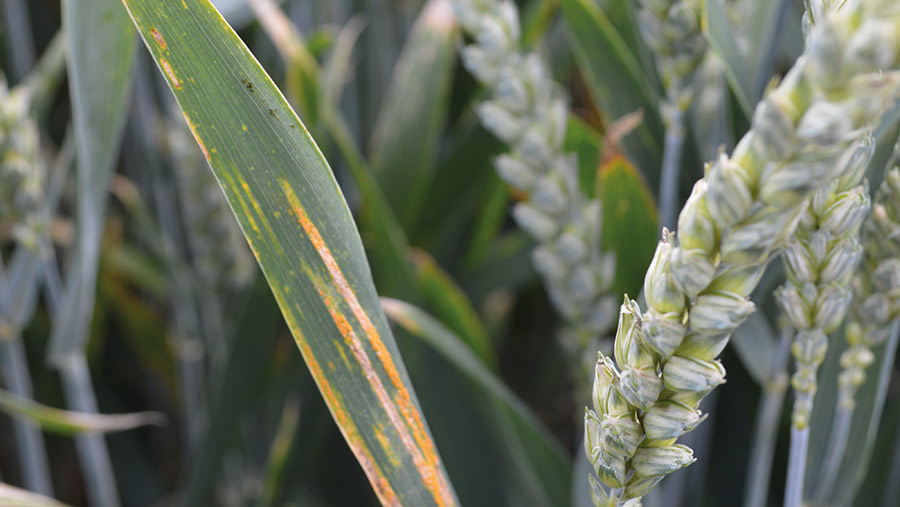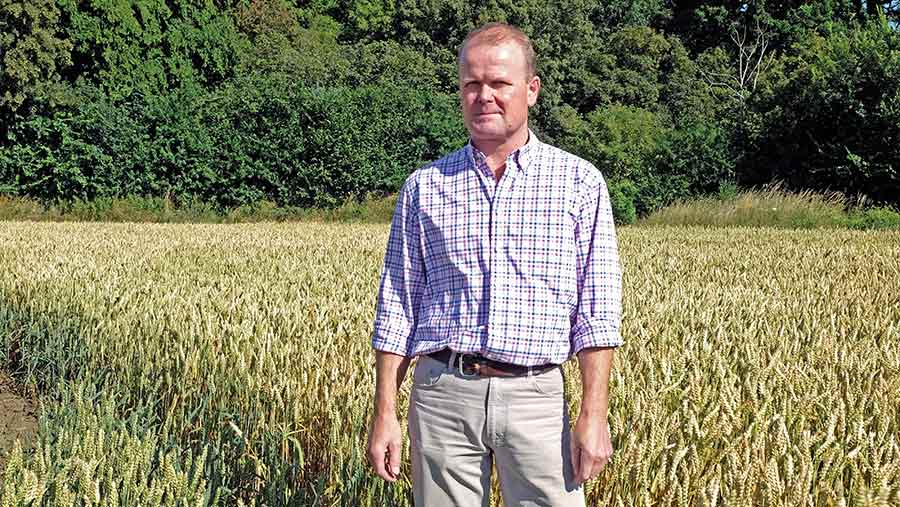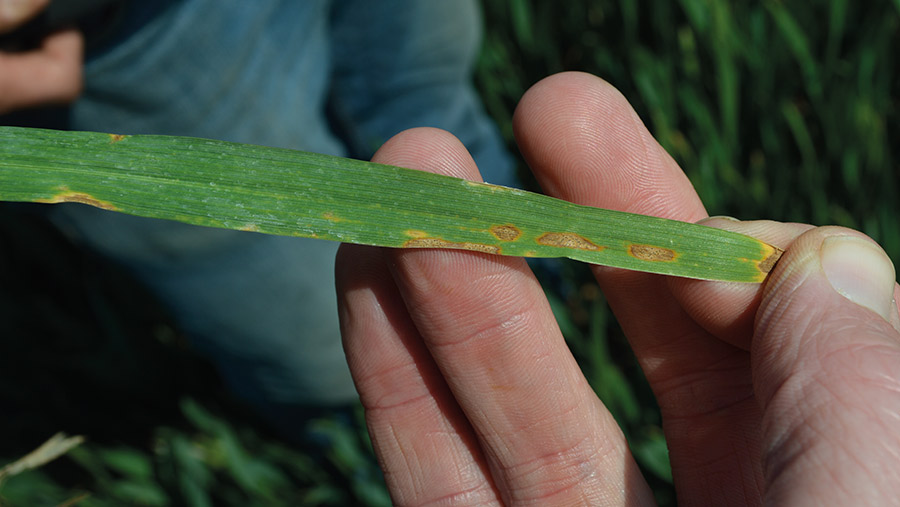How a free test is keeping one wheat grower on top of disease
 © MAG/David Jones
© MAG/David Jones Edward Vipond is using a free DNA test on his winter wheat crops to give him an early warning of septoria and yellow rust diseases developing, and to make sure his fungicide programmes are spot on to deal with these often hidden threats.
The Suffolk farm manager conducted these tests last season to see inside his wheat leaves and check on the level of latent septoria, and be prepared for a sudden attack of yellow rust ahead of his two main fungicide spray timings.
See also: Benefits of septoria tests in optimising T2 fungicide rates
The test is offered for free by agrochemicals giant Bayer as part of its rapid disease detection initiative, called CropCheck, to analyse the amount of septoria and yellow rust DNA present in wheat crops before visible signs of the diseases are seen.
“It is an early warning system as it gives me an indication of disease levels, especially important as I walk all the crops myself,” he tells Farmers Weekly.
Traffic lights
The test gives a traffic light system of red to green to warn of impending disease dangers, and allows Mr Vipond to select fungicide products and tweak spraying rates to give the most effective disease control.
Growing 400ha of winter wheat, with three-quarters of the area down to milling varieties Crusoe and Skyfall, and the rest in soft wheats such as Astronomer and Skyscraper, he is keen to keep a close eye on costs, with his wheat fungicide programme typically costing £100-£130/ha.
Mr Vipond manages four farms totalling 1,450ha for the Claas family based at Troston, about six miles north of Bury St Edmunds, on land ranging from blow-away Breckland sand to heavy clays, and stretching across a 20-mile radius.
Troston Farms, Suffolk
Farming 1,450ha of which 1,200ha is cropped with milling winter wheat, milling, feed and forage rye, sugar beet, spring barley, maize, winter beans and sunflowers.
The wheats are grown on three of the farms with heavier soils with a five-year average yield of 9.2t/ha, while the fourth very light farm at Troston village only grows rye and sunflowers.
Two varieties
Last season, he tested two varieties of soft wheat, Astronomer and Skyscraper, ahead of his T1 fungicide timing in late April, taking about 12 leaves from a field to make up a sample.
These were leaf fours of the plants as the T1 spray looks to target the emerging leaf three.

Edward Vipond © Jason Bye
The spring of 2022 was generally a low disease season due to dry weather, so it was important to find out if there was any disease present in the crop not yet visible on the newer leaves.
The DNA test results are known in a few days, and disease was detected in 2022, so a “solid” T1 fungicide spray was used.
“There was disease there so it gave me the confidence to use a robust T1 spray as opposed to cutting back,” he says.
Mr Vipond used the two SDHI bixafen + fluopyram plus azole prothioconazole product Ascra at 1 litre/ha at T1, which followed an application of the azole tebuconazole at T0 in late March to protect against yellow rust.
His inclination is to spend money at the T1 stage as the era of cheap T1s is largely gone with the recent banning of the very effective and economically priced protectant fungicide chlorothalonil.
Further DNA test
Although the weather stayed dry into May, a further DNA test one week before the planned T2 flag leaf spray showed septoria disease was in the crop, and as 2021 turned out to be a very difficult year for disease control, he was determined to stay on top of disease in 2022.
He applied a robust rate of 1 litre/ha of the picolinamide fenpicoxamid plus azole prothioconazole product Univoq at T2.
This was without any damage to his sprayer as the product has been reported to have caused problems with some farm sprayers.
Good disease control was obtained from the fungicide programme, although septoria was always present on the lower leaves of the two varieties.
Astronomer has a 6.2 rating for septoria and Skyscraper is down at 4.9, on a 1-9 scale where 1 is susceptible and 9 shows good resistance.
This season, he is trying a number of other soft wheats as well as Astronomer, such as Bairstow, Stokes and Saki, with Skyscraper dropped from the farm.
The test was not been used ahead of T3 head sprays, where he usually applies the strobilurin azoxystrobin (Amistar) plus prothioconazole + tebuconazole (Prosaro) on the milling varieties.
Free testing service
Bayer has been running the free CropCheck service for a number of years, but its popularity has picked up in the past couple of seasons and, in 2022, it tested 4,000 samples sent in by agronomists and growers.
The test uses rapid quantitative polymerase chain-reaction (qPCR) analysis to pick up septoria, which can be latent in the crop for up to three weeks before visible signs are seen, while yellow rust cycles are much quicker in about four days.
Greg Hanna, the group’s market development agronomist, says the test is aimed to be used one week before the key T1 and T2 spray timings, and the results will allow growers to select appropriate products and tweak rates.
“The tests will help growers to focus on priority crops, and give them more confidence over their fungicide strategies,” he says.
In a very high-risk disease situation, growers could even look at testing before the T1-1/2 timing in early May by sampling leaf threes.
Red, amber or green
For septoria, the DNA test will give a red, amber or green rating.
Mr Hanna says the group sees few red signals when the situation is very serious and where the disease is likely to be seen in the next few days, while amber growers need to get out with a fungicide spray as soon as possible.
The green signal is the “perfect scenario” and potentially means that if an SDHI/azole product is selected then it could be used at a low rate.

Septoria on young wheat leaf © MAG/David Jones
Mr Hanna adds that the green situation is where the protectant non-systemic fungicide folpet gets the best results.
For yellow rust, because the disease can cycle very quickly in as little as a few days, then only red and green signals are used and no amber.
Mr Hanna points out that growers are advised to look at their varieties, drilling dates, geographic locations, whether crops are first or second wheat and what type of tillage is used before deciding on fungicide strategies.
Bayer started its own monthly testing at 16 sites across the country in January and February this year, and then it will test every week through March to June.
Those growers or agronomists interested in obtaining a free test are advised to contact their local Bayer commercial technical manager.
A rival DNA test is available from Microgenetics, called SwiftDetect, which was launched in 2020, but there is a charge for this detection test.

